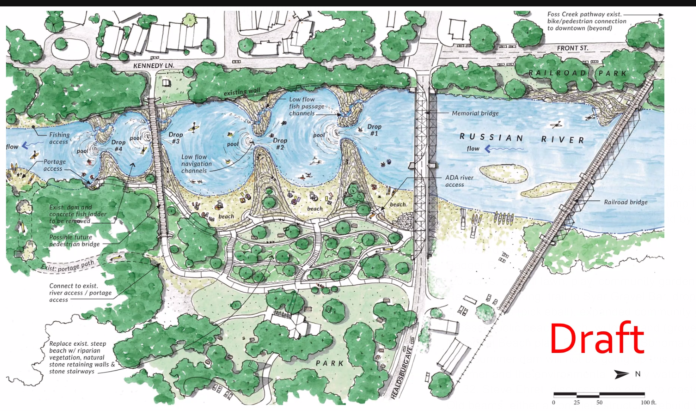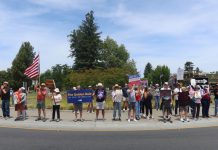
The Sonoma County Regional Parks department is in the early stages of exploring an idea to turn the seasonal summer dam at Healdsburg Veteran’s Memorial Beach into a series of about 18 inches of drops, which would create four mini pools for lazy river-style tubing, family-friendly swimming and fishing.
The early concept is a result of the need to either rebuild the aging dam infrastructure, or create an alternative option in lieu of the dam. The concept includes low flow channels for fish passage, portage access, fishing access, trails and three separate beaches.
“Along with climate change and very low flows, comes blue green algae when flows are stagnant from the dam and (there are) structural issues with the I-beams for the dam. Fish permitting is really challenging and we’d either need to do a complete structural rebuild or consider other alternatives,” said Steve Ehret, a project manager with Sonoma County Regional Parks. Ehret introduced the project idea to the Healdsburg City Council on May 17.
According to the city of Healdsburg, Russian River flows near Healdsburg have fallen to 33 cubic feet per second. Normal flows for this time of year are typically 80 cubic feet per second.
“We’ve had several public meetings and we’ve done stakeholder engagement, we’ve had intercept surveys at the Healdsburg Farmers Market and in the park. We’ve done online surveys, all the usual stuff, and we’re building up to a range of options and we’ve presented three different alternatives for the upland area,” Ehret said.
The current proposal is to convert the dam into a series 18 inch drops.
“You’ll notice a series of pocket beaches, but you’ll see there are no dams,” Ehret said, pointing out the draft rendering of the project, adding in part, the idea came from Regional Parks’ Director Bert Whitaker’s vacation where Whitaker saw a similar style project.
“Every one of these has been a dam conversion, usually for safety issues, and it gets turned into a float park or a white water park or a family-style slow, lazy river-type of park and the transformation has been wildly successful in all of these communities that have done so and we’re really interested in seeing if this will work here,” Ehret said.
He said there are around 150 similar projects around the country and the vision for this particular project is to have an area with shallow drops perfect for kayaks, tubes or swimmers.
“The surrounding banks are hardened in some areas for flood control and also for nice sunning (spots) and a safe way to approach. We really want it all, we want summer swimming and we want summer paddling and we want a water recreational resource for most of the community who doesn’t have a pool in their backyard, we do feel that it’s an equity issue and we think this may provide the way forward,” Ehret said.
He said all of the experts they’ve engaged with so far believe the project is feasible. “We’re interested in taking it to the next step,” he said.
Additionally, the regional parks department is working on new alternatives for the upland area and combining it with the ideas along the river so people and fish can harmoniously coexist.
“Our hope is to be out with these very shortly in June with updated alternatives for feedback,” Ehret said.
He said the goal is to get started on all associated environmental work and environmental studies this August. “It’s gone from a wild idea to something that actually looks possible and real even in our heavily regulated Russian River, it may just be the solution that brings everything together,” he said.
Following the brief presentation, Councilmember Skylaer Palacios asked what the environmental impacts would be of removing the summer dam.
“That will be a part of the exploration of completing an environmental document. Certainly what we’ve learned from talking with (others is) many of these have come up due to hazardous conditions and in some instances you actually saw habitat restoration or improved connectivity in the area,” Whitaker said. “In conversations with Sonoma Water, (the question) is there an opportunity to actually enhance fish passage in a meaningful way year-round as opposed to the current situation with the summer dam that we raise where we do not have upstream fish passage, which has been a sticking point for regulators.”
He cited the concern that at some point regulators may demand to have an inefficient and expensive fish ladder installed if the summer dam option were to continue.
Whitaker said for areas that have implemented the tiered drops, “Most have seen pretty significant revitalization in areas along the river.”
Vice Mayor Ozzy Jimenez asked what the costs would be for a project of this magnitude and Whitaker said to be perfectly honest, they don’t know what it’s going to cost at this point.
“We won’t get a handle on that until way further into the design and engineering (stage),” Whitaker said, adding the majority of regional park projects are fulfilled by a variety of funding sources such as state and federal funds.
“There are typically six to 15 funding sources that make these projects go,” he said.
Councilmember Ariel Kelley said she’s excited about the direction of this project.
“I grew up in Oregon and spent a lot of time in Bend growing up and I’ve seen the way that’s evolved there on the Deschutes and it’s such a beautiful way to engage the community and recreation and river access, so I’m really excited to see where this may go,” Kelley said.
Ehret and Whitaker noted that the summer dam won’t be going up this year due to low water flow, however, lifeguards will be on duty this summer at Healdsburg Veteran’s Memorial Beach.








